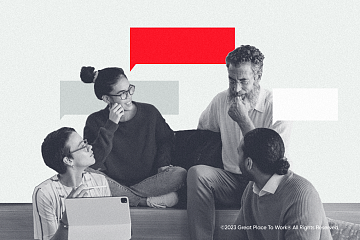Employee Experience, Employee Well-being, Retention Strategies
Is 2023 the year when companies walk back pandemic-era efforts to improve well-being?
How will employers invest in their workplace wellness in 2023?
Some companies are cutting costs to increase profits. Google dismissed its head of mental health and well-being as part of its recent layoffs, along with others on the mental health team.Wellbeing Trends in 2023
Employee well-being is one of the biggest differentiators for companies on the 2023 Fortune 100 Best Companies to Work For® List compared with a typical company. For employees at one of these top companies, 83% report having a psychologically and emotionally healthy workplace. At a typical U.S. company, only 52% report the same.
Even for industries particularly disrupted by the pandemic, high levels of mental health on the 100 Best list strongly outperformed the average.
And the benefit? Companies on the 100 Best saw big leaps in productivity, even as annual U.S. hit a record low, per the Bureau of Labor Statistics.
“Economic uncertainty may be a test of companies’ mettle in maintaining a commitment to investment in employee wellness — especially at current levels,” says Dr. Tamarah Duperval- Brownlee, (or Dr. Tam, as she's more widely known), chief health officer at Accenture. “Will they be able to continue offering a robust and holistic employee experience? That will be a challenge.”
A challenge that companies like Accenture, No. 5 on the 2023 100 Best list, are taking head on.
Experts at Great Place To Work® argue this is exactly the wrong time to pull back on well-being. Research has shown that the employee experience directly correlates with a company’s ability to thrive in a recession.Here’s where companies that are investing in well-being in 2023 are focusing:
1. Focus on flexibility.
“We know it's not a one-size-fits-all approach,” shares DeAnne Aussem, well-being leader at accounting giant PwC for its U.S. and Mexico operations. “We know our people are at different points in their professional and personal lives.” For PwC, No. 30 on the 2023 100 Best, flexibility means personalizing the work experience, from remote work policies to offering time away from the job.
“We were the first of our peers to introduce virtual roles to all of our 40,000 client service professionals, and about 78% or so at that time chose a hybrid option,” says Aussem. “We heard a lot of great feedback about how much our people appreciated being able to choose — we even saw an immediate 20% increase in job applications to the firm following the announcement.”
Flexibility is also an important part of the well-being strategy for employees who can’t work remotely.
“For our hotel teams, we're driving flexibility and choice from a scheduling perspective — giving associates more control over their situation and providing more choice over the hours and days they work,” says Judy Fennimore, vice president of benefits for Marriott International (No. 10 on the 2023 100 Best).
Financial services firm Synchrony, No. 20 on the 2023 100 Best, is also thinking about flexibility for all workers, not just salaried office employees.
“We've launched new pilots and programs to better meet the needs of our hourly associates,” shares DJ Casto, chief human resources officer for Synchrony. The company has invested in accommodating employees’ preferred schedules, including splitting some shifts into two and offering 30-hour work weeks with access to full-time benefits.
To be this flexible, organizations have to embrace a different operational strategy, one that prioritizes outcomes rather than “productivity theater.”
“Employees want less prescriptive management of how they spend their time and more focus on the high impact results they deliver,” says Accenture’s Dr. Tam. "They want more flexibility during the day and expectations have shifted around always being 'on' or round-the-clock availability for work."
2. Fight burnout with time off.
“As we continue into 2023, the biggest threat to employee well-being is burnout,” says Casto.
In a new study from UKG’s Workforce Institute, almost half (42%) of middle managers say they plan to quit in the next year due to workplace stress and anxiety.
To fight burnout, the strategy is simple: Get employees to take breaks and recharge.
PwC created a program where employees can take a leave of absence of four weeks to a maximum of six months while retaining 20% of their pay and benefits. Employees qualify for the benefit as long as they work 30 consecutive days before starting their leave.
“It gives them time to do something else they are interested in and passionate about,” explains Aussem.
“Today’s workers demand an employer who listens and acts — or they will leave for one who does." - DJ Casto, CHRO, Synchrony
Similarly, Synchrony offers a sabbatical, where employees can take up to one year of dedicated time off while retaining full benefits or reduce their work schedules. Synchrony employees qualify for the benefit after being with the company for at least one year, and can use the time to focus on themselves personally or professionally.
PwC has also made it a priority to encourage all employees to take a week off at the same time twice a year, allowing everyone time away without emails and to-do lists piling up on their desks.
“What we try to do is have the vast majority of our folks fully disconnect together,” says Aussem. When the whole company takes time away at the same time, the result is a behavior change where colleagues support each other in their attempts to fully log off.
Synchrony also encourages employees to take time away from work. The company launched “Flex Fridays” to combat meeting fatigue, with employees encouraged to avoid morning meetings on Fridays and take the afternoon to unplug from work.
3. Invest in caregivers.
“Caregiver responsibilities and other challenges continue to increase for the sandwich generation — people having to care for both aging parents and children — and for working parents,” says Demetris Crum, vice president, total rewards at AbbVie. “These responsibilities not only strain work-life effectiveness, but also take a toll on mental health.”
AbbVie, No. 79 on the 2023 100 Best, provides increased caregiving support for a range of needs, including backup care for child and eldercare, mental health support, tutoring discounts, and online homework assistance. For U.S. employees in 2022, AbbVie introduced caregiver leave: four weeks of paid leave (and eight weeks of unpaid leave) in a 12-month period to care for a family member with a serious health condition.
To fight burnout, the strategy is simple: Get employees to take breaks and recharge.
For Synchrony, concern for caregivers led to increased family leave, up to 22 weeks fully paid for birthing parents, which can be taken at any time during the child’s first year. The company also expanded its back-up care program to help employees with elder care or childcare needs.
4. Offer financial education.
Financial stress has been on the rise amid rising inflation and recession fears.
“We understand that the uncertain economic outlook may cause concerns for associates,” says Fennimore. “As a business, we're focused on proactively addressing these concerns and investing in more financial well-being education and resources over the coming year.”
Marriott recently enhanced its retirement plans, launched an employee stock program, and offers financial wellness programs designed to educate employees on how to build financial stability.
5. Prioritize mental health.
Mental health continues to be a crucial concern for employers in 2023.
Just 16% of U.S. workers are in a high state of well-being, according to Great Place To Work, which corresponds to a recent Gallup poll that found 19% of U.S. workers rate their mental health as fair or poor, costing $47.6 billion in unplanned absences from work each year.
“It's clear the pandemic has exacerbated the rates of stress and loneliness, and at Marriott, we’re focused on supporting associates’ mental health,” says Fennimore.
According to research from UKG, employees say managers have a greater impact on their mental health than doctors or therapists.
For Marriott, mental health support includes free access to a digital mental well-being platform that offers personalized resilience solutions and training, and mental health coverage in health care plans.
6. Develop a sense of belonging.
For leaders who are concerned about fractured relationships and a lack of cohesion across their workforce, it’s time to focus on belonging and camaraderie.
“The pandemic has changed how we work,” says Dr. Tam. “People are feeling a range of emotions about the experience. Employers who focus on re-building community will help their employees return to where they’re thriving.”
At Accenture, building community also includes a look at diversity, equity, inclusion, and belonging (DEIB). A potent tool? Employee resource groups (ERGs).
Listening is also how leaders show their commitment to well-being as a company value.
“Our people also have access to affinity groups that align with their interests and foster a sense of belonging,” says Dr. Tam. "Our ERGs provides opportunities for networking, professional development, and community involvement."
7. Leverage technology.
Several of the leaders we spoke to are excited about the power of technology to create solutions that improve the well-being of workers.
At PwC, coordinating employees’ time off is made possible by a digital assistant that makes it easier to plan and take uninterrupted time off. “The use of technology to help drive that positive behavior change is what we're aiming for,” says Aussem.
Accenture predicts more and more companies will use virtual and digital tools to create more robust well-being programs. “Our people can access in-person and virtual counseling through digital tools like Calm and Wysa and an internal Mental Health Ally program,” Dr. Tam offers as examples.
8. Listen, and then listen again.
Every leader we spoke with highlighted the importance of listening to your people to determine the best well-being solutions for your organization.
“Today’s workers demand an employer who listens and acts — or they will leave for one who does,” says Casto.
“We have a variety of listening channels,” says Aussem about how PwC seeks feedback. Channels include focus groups, staff councils, employee resource groups, and surveys.
“We are relentlessly focused on getting feedback from our people to validate that what we're doing is working, and it’s even more important in helping us understand what else our people may need from us to succeed.”
Listening is also how leaders show their commitment to well-being as a company value.
“Employees are looking for a culture where their leaders and teams are committed to their well-being as a priority,” says Dr. Tam. “They want employers to take a step back and recalibrate ways of working to support their well-being.”
Make a list
Think you belong on one of our Best Workplaces™ lists? Start your journey today with Certification™ and share your company story with the world.














